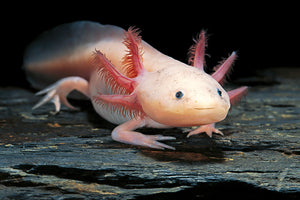Getting an Axolotyl
Axolotls are amphibians and come from a species of salamander. They originate from Mexico, where they are native to an increasingly small number of channels and lakes. They originally inhabited lakes and wetlands in the Mexican Central Valley.
However, they have largely disappeared from many of these and are now only known from three sites in the southern part of Mexico City in central Mexico. Axolotls have wide heads, short limbs and three pairs of feathery external gills. Their gills are not just for show – they are used for breathing and excreting waste. Usually, salamanders lose their gills during metamorphosis, but axolotls retain theirs for life.

Axolotls also have functional lungs and occasionally surface to take a gulp of air. They are neotenous, which means that they retain their juvenile characteristics into adulthood. Sexual maturity is reached at a year old. There are different morphs and colours of Axolotls, ranging from grey or pink to black or gold speckled. Axolotls are mostly calm and relaxed animals, but they can become quite active when they have settled into their environment.
They are solitary creatures usually, but some will live together harmoniously. Although be careful of any nipping of limbs of others and be ready to separate them if you do have more than one and see any aggressive behaviour.

They should never be kept with fish. Size: up to approximately 12 inches Speed: up to 10mph (15kph) Nickname: Mexican Walking Fish Life expectancy up to 10 – 15 years under ideal conditions
Housing

Your Axolotl needs a cold water tank, with no gravel (they like to eat it otherwise); bare bottom or sand is best. Sand will not impact in your Axolotl’s digestive system if eaten and aids the Axolotl in gripping onto something at the bottom of the enclosure. Some people prefer sand to a bare bottom tank to give a more natural look. If you choose a bare bottom tank, make sure your Axolotl has somewhere to “perch” on, such as a ledge or rock near the bottom of the tank. Axolotls like hiding spaces, such as tunnels, hollowed-out rocks and caves. Live or plastic plants can also be added and other decorations. Please be aware that live plants are good when they are healthy as they help the nitrogen cycle of your tank, but any rotting matter will need to be removed, as it will raise the levels of ammonia, nitrates and nitrates in your tank. The bigger the tank you get, the better; Axolotls like to explore their surroundings. Ideally a tank no smaller than 2ft long (61cm approx.) would be a good starter, but remember Axolotls grow, so you will likely need to upgrade in the future if you start off with the smallest size tank as they can grow to 12 inches long (1ft).

Temperature

They are cold blooded animals so a heater is not required in the tan and the ideal temperature range is 16-18 oc. Usually this temperature is easily achievable in normal weather conditions, but some households are naturally warmer than others. You can add frozen water bottles to the water or add a fan near the tank during warm weather. Some Axolotl owners may choose to invest in a water chiller. In cooler weather you may need to add warmer water to raise the temperature and water conditioner must be added to any new water you add to the tank. Filtration - We recommend a filter due to the amount of waste Axolotls produce; otherwise water changes every other day will be necessary. It is better to have a low flow filter when your Axolotl is juvenile, so the water flow is not too strong for your pet and push him/her around the tank. A filter with a adjustable flow is the most ideal.

Lighting
No lighting is required in the tank. Axolotls prefer dim, indirect light. If an axolotl is presented with the option of living in a brightly lit environment or a darker space, they will almost always choose the dark space. Overly bright light causes axolotls stress and may lead to an unhappy pet.
Getting Your Water Ready
Before adding any water-based animal, you must make sure your water is ready. Add any furnishings, substrate and plants to your tank and then fill with water. You must add a water conditioner to eliminate harmful chemicals – it must be aloe vera free; we stock API water conditioner for our Axolotls. The packaging will instruct on how much you need to add to your water, depending on the size of your tank. Once all this is added your tank will start to go through a cycle, whereby the bacteria will cause ammonia and nitrates and nitrates to be present in your tank. Your tank will learn to go through the cycle and control these (although as with fish sometimes intervention is needed and a treatment may need to be added).
A tank can take anywhere from a week plus to cycle when you first set it up and will depend on your tanks size and can also where it is located in your house. After 1 week you must test your tanks water with testing strips to ensure the PH and chemical levels are correct and don’t cause any ill-effects. It is also advisable to test with ammonia strips as well, as even 0.25ppm of ammonia can cause burning to an Axolotl’s gills and put extra pressure on their breathing. If the levels are safe, your Axolotl can be added.
If they are not, you may need to do a water change or other type of intervention to aid the water, which your pet shop can advise you on. You can then re-test again to see if the intervention has worked. Axolotls are sensitive to stress-related diseases and changes to their water conditions, so it is very important to keep their conditions good.
Water Changes
Even after you have set up your tank, regular water testing is also needed to ensure your water condition is suitable for your pet throughout its life. You should do a water change approximately every 1-2 weeks, or more frequently if required by your water test results. Make sure to only remove 25-30% of the water, so you do not remove all the good bacteria from your tank. Make sure to add water conditioner to any new water you add to your tank.
Cleaning
Remove droppings and any uneaten food or plant waste twice daily. You should check regularly that your filter is running correctly and not clogged. Wipe down any algae off the sides of the side as often as needed. A full tank clean should be done approximately every month and 50% of the water removed and changed. As with smaller water changes, make sure to add water conditioner to any new water you add to your tank.
General care
A healthy Axolotl should be bright, alert and active and not too pale in colour. Signs of stress are forward pointing gills, a curled tail tip, or a lack in appetite. Other signs of illness to watch out for are redness on their skin, fungus on their gills, or their slime coat coming off. If your Axolotls is nipped by another or catches itself on something in its tank, it could hurt one of its limbs. However, incredibly an Axolotl can grow back lost limbs in only a few weeks. It can even regenerate its lungs, heart, spinal cord and parts of its brain, if it suffers a head injury and heals without any scarring. A study by the University of Minnesota found that a protein called c-Fos is crucial for the regeneration process
Feeding
Axolotls are carnivorous and live off a protein rich diet and will eat a variety of different things including live earthworms and black worms, bloodworms, shrimp and daphnia (live, frozen or freeze-dried are available but live or frozen are more nutritional)

Feeding amounts and type of feed vary depending on the age.
| Size (Inches) | State of life | Frequency (times per day) |
| Under 1” | Hatchling | 2 x per day |
| 1.5” to 3“ | Baby | 1-2 x per day |
| 3” to 5“ | Juvenile | 1 x per day |
| 5” to 8“ | Subadult to Adult | Every other day |
| Over 8” | Adult | Every 2 – 3 days |
If your axolotl refuses food numerous times and you are on a more frequent feeding schedule, it may be time to lower the amount of feeding per day. This is not to be confused with a general lack of appetite, as this can be a sign of illness. If you are at all worried about the health of your Axolotl you should consult your vet or a specialist Amphibian vet as soon as possible.
Shopping List
| ESSENTIAL | OPTIONAL |
| Tank | Substrate - sand |
| Water Conditioner | Live Plants |
| Water thermometer | Water cooler/chiller |
| Filter | Wormery |
| Décor/furnishings | |
| Water general testing strips | |
| Water ammonia testing strips | |
| Food | |
| Cleaning supplies |
Remember you must never release your pet into the wild

